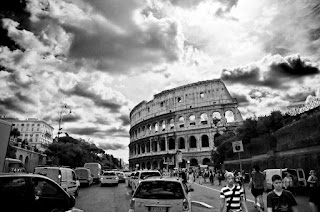
Rome's Colosseum. D3/24-70mm f/2.8G 1/400th f/13 ISO200 @24mm.
I hardly ever take pictures of "stuff" anymore. I hardly ever use my camera outside the typical photoshoot. Understandably it was quite refreshing to just be out and about shooting "stuff".
With all my my retouching skills I wondered whether or not they'd be applicable to non-beautiful women. I mean, so much of what I do is content-specific; fixing skin, flyaway hair, liquifying away chunks of flab. Would any of these be applicable towards retouching landscape per se?
Yup.
And oh how easy it is versus making women more beautiful. Now I know why the guys over at Luminous Landscape can live in their bubble. It's fun shooting scenery, but above all it's easy as heck to work with/manipulate in post.
I shot the above and ran it through a sky-saturating preset in Lr before running it through my typical processing in PS. All-in-all about 4 minutes of work. My objective was to create a high-contrast image. It's almost too-high-contrast. In a away it's HDR-looking but I assure you this was a single exposure (read: NOT HDR). My goal therefore was to stretch out the tonal range in the histogram.
Most of B&W's expressiveness is in its tonal range. I haven't come across too many places (online) that really explain that. The rationale is simple; big tonal range equals high contrast... and B&W images need tonal range to really pop and evoke emotion. Thus when you're retouching, look at the histogram. Does it stretch from the far left to the far right? If so, then you have great tonal range. If not then try to stretch it out in PS/Lr. The exception/problem is that when you're shooting people, it's sometimes hard to get great tonal range in the skin. Then it becomes a question of lighting as well as retouching.

Cool shot Charles!
ReplyDelete